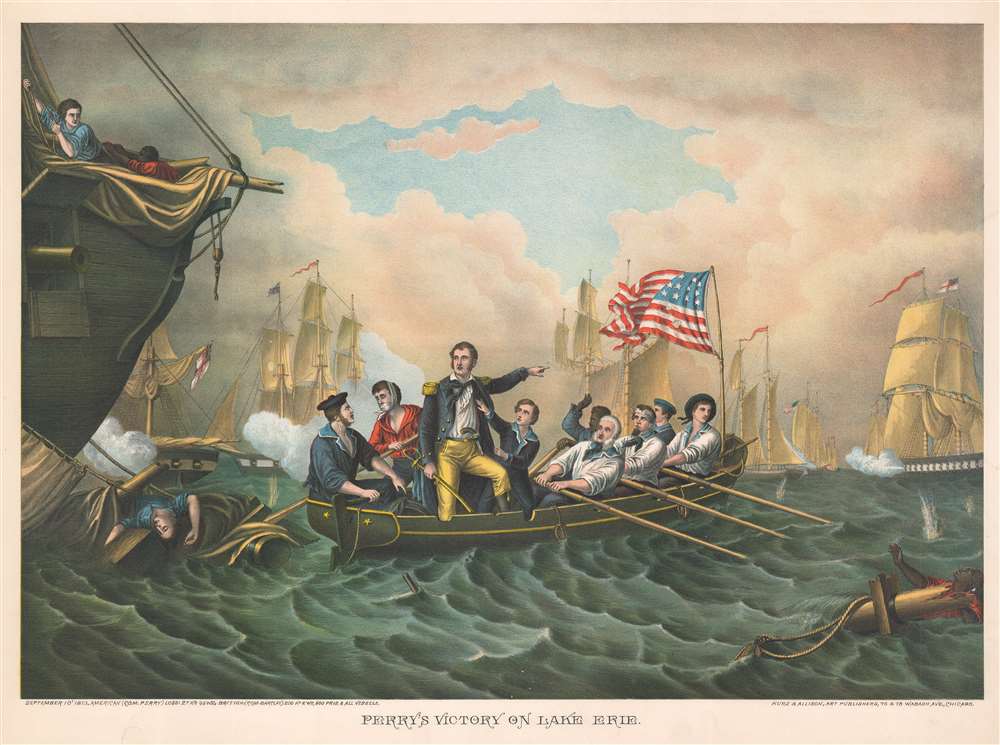1889 Kurz and Allison View of the Naval Battle of Lake Erie (War of 1812)
PerrysVictory-kurzallison-1889
Title
1889 (undated) 18.75 x 25.5 in (47.625 x 64.77 cm)
Description
The Battle of Lake Erie
The Battle of Lake Erie, fought on September 10, 1813 during the War of 1812, was one of the biggest naval battles of the war and proved to be a pivotal American victory. Perry was given command of the squadron at Presque Isle, Pennsylvania, earlier in 1813 and oversaw the construction of both the Lawrence and Niagara. After the British blockaded Presque Isle for ten days in July 1813, Perry sortied his squadron from Presque Isle in search of a more accessible anchorage, which he found at Put-in-Bay, Ohio. On the morning of September 10, upon seeing the British approaching, Perry organized his squadron in a line of battle and engaged the Royal Navy squadron. Perry's flagship, the Lawrence sustained heavy damage, so much so that he had to transfer his command to the Niagara. After the surrender of the Lawrence, the British expected the Americans to retreat. However, Perry captained the Niagara and the rest of his force toward the already damaged British ships and engaged them once again. Not long after, the entire British squadron (two ships, two brigs, one schooner, and one sloop) surrendered to Perry, giving the Americans complete control of Lake Erie. In his letter informing Major General William Henry Harrison of the victory, Perry wrote his now famous words, 'We have met the enemy and they are ours'.Chromolithography
Chromolithography is a color lithographic technique developed in the mid-19th century. The process involved using multiple lithographic stones, one for each color, to yield a rich composite effect. Oftentimes, the process would start with a black basecoat upon which subsequent colors were layered. Some chromolithographs used 30 or more separate lithographic stones to achieve the desired product. Chromolithograph color could also be effectively blended for even more dramatic results. The process became extremely popular in the late 19th and early 20th centuries, when it emerged as the dominate method of color printing. The vivid color chromolithography produced made it exceptionally effective for advertising and propaganda imagery.Publication History and Census
This view was created and published by Kurz and Allison c. 1889. This view is not cataloged in OCLC and we note only one cataloged example in an institutional collection at the National Museum of American History. We note a handful of instances when the view has appeared on the private market.Cartographer
Kurz and Allison (1880 - c. 1905) was an American publishing firm known for its chromolithographs. Founded by Louis Kurz (1835 - 1921) and Alexander Allison, the firm was based at 267-269 Wabash Avenue in Chicago. In the partnership, it is known that Kurz, an Austrian immigrant, was the lithographer and it is presumed that Allison provided the financial backing. The firm is most well-known for its series of thirty-six battle scenes from the American Civil War. At the time of their publication, the late 1880s and early 1890s, a general nostalgia was prevalent among Civil War veterans (of which Kurz was one), and evidently the company was trying to capitalize on the sentiment. Kurz and Allison's Civil War prints were not the first such prints to be issued, but they were by far the most popular. In a style reminiscent of Currier and Ives, Kurz and Allison lithographs are not meant to be historical representations, and even, from time to time, included historical inaccuracies. Even so, 'prints depicting the Civil War battles by Kurz and Allison are among the most sought-after collectibles of Civil War enthusiasts.' Their prints are also notable for featuring African-American soldiers, a rarity for the era. After the outbreak of the Spanish-American War, the firm published views from famous battles and continued doing so for the campaigns of the Philippine-American War and the Russo-Japanese War. More by this mapmaker...

